| |
|
|
| We thoroughly enjoyed Central America.
Sometimes culture shock hit us hard and and other times we were amazed
by the natural beauty. We had a great old time and thank Guatemala,
Nicaragua, Costa Rica and Panama for their kind hospitality. Wish
we could have stayed longer. Below, in reverse chronological order,
are our notes on Central America. |
|
| |
|
| |
|
Panama Heat
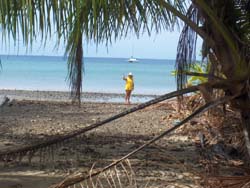 Panama is the gem of central
America. Undiscovered, much of it remote and untouched by modern
civilization, we have been delighted with our explorations of Panama.
Did you know, Panama is the only place on the continent where you can
see the sun rise over the Pacific? Panama is the gem of central
America. Undiscovered, much of it remote and untouched by modern
civilization, we have been delighted with our explorations of Panama.
Did you know, Panama is the only place on the continent where you can
see the sun rise over the Pacific?
Although Panama's cities can be a bit gritty and downright dangerous in
places, Panama as a whole is a delight. Low cost, friendly people,
many remote unsettled locations and lots of cool places to hang out.
And it is the best place to work on your boat since San Diego.
First there are the Islands, the sparkling gleaming islands dotting the
seascape as you journey deep into Panama.
Isla Seca's crystal clear waters and golden beaches are
brilliant. It is an exquisite location where thousands of tropical
fish, flash through the waters, with occasional turtles and a rare
shark. The water is so clear that your vision tells you the water
is only a few feet deep, but the depth sounder reads 25-40 feet.
Click the picture at the left to view one of these picturesque islands
or click here for a
slide show.
Bahia Honda was another paradise, this one populated by
friendly locals who showed us their idyllic way of life. Little
money or things to spend it on, ample food for the picking. No
cars and no roads as we know them. It was amazing. Click
here to see.
Then there is Las Perlas (The Pearls). Dozens of picture perfect tropical islands
just 40 miles away from the very cosmopolitan Panama City! A couple of
the islands, Chapera and Mogo Mogo are where the TV show Survivor Panama
was filmed. They were very beautiful. Click
here to see some of
Panama's pearls.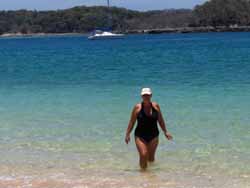
After enjoying the islands we did five days hard labor in the Panama
heat at the Flamingo Marina. We hauled the boat out of the
water and carried out our annual maintenance. Gasp! The
heat! The humidity! Sweating like never before in our lives.
Huge balls of sweat from every pour on our bodies, sweating from the eye
lids, sweating our chins. Our shirts and pants constantly soaked. Click
here to see what a fun
time we had.
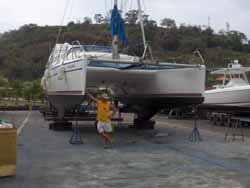 But
the hard labor is done and we are back in the water. Mustang
Sally is looking spiff, leaks plugged, rudder delam-fixed, props cleaned
and re-zinced, leg oil changed, exterior polished and waxed, and the
bottom painted. But
the hard labor is done and we are back in the water. Mustang
Sally is looking spiff, leaks plugged, rudder delam-fixed, props cleaned
and re-zinced, leg oil changed, exterior polished and waxed, and the
bottom painted.
Ready for the Ecuador trip? Not quite. We need a
couple of weeks to chase down the other things we need for the South
America and the South Pacific. Oh yeah, we also have to explore
Panama City and relax. We are moored at the
Balboa Yacht Club. What fun watching all the
boat traffic!
It seems I have only a few pictures of Panama City. Click
here to see them.
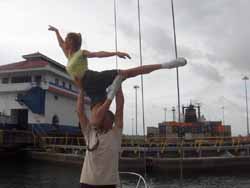 What would a visit to Panama be without a trip to the canal. What
the hell, why not trough the canal. We joined Tod and Jenn on
their 44 foot Columbia for a trip through the canal. Our hosts
were very generous and made sure we had a great time transiting the
canal. We had a blast! Click
here to see some of
the fun. What would a visit to Panama be without a trip to the canal. What
the hell, why not trough the canal. We joined Tod and Jenn on
their 44 foot Columbia for a trip through the canal. Our hosts
were very generous and made sure we had a great time transiting the
canal. We had a blast! Click
here to see some of
the fun.
|
|
| |
|
| |
|
| |
|
Costa Rica
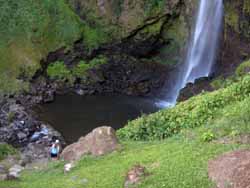 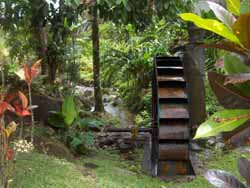 Costa Rica is a beautiful
unique Central American nation. The uniqueness makes it a very special
place. Here are some of the things that set Costa Rica apart: Costa Rica is a beautiful
unique Central American nation. The uniqueness makes it a very special
place. Here are some of the things that set Costa Rica apart:
1) The country escaped the violent civil wars that plagued other Central
American countries in the last decades of the 20th century;
2)
Unlike other Central American countries, the United States government
mostly kept out of Costa
Rican politics.
3)
Costa Rica doesn't have an army;
4)
The people are environmentally conscious and large chunks of land are
set aside as ecological reserves;
5)
The population is largely Spanish decent where other Central American
nations are primarily Metizmo and native.
All these things combined with a abundance of natural beauty make Costa
Rica an extraordinary place.
It was a sailing adventure getting to Costa Rica. A local
weather condition called Popagyo winds blasted us with 25-35 knots of
head winds for three days and nights. These hot gusty winds are
powered by high pressure systems driving the Caribbean trade winds into
the Central American continent, over the mountain ranges and into the
Pacific.
Our tactics for dealing with these highly unpredictable winds was to
sail close to shore where minimum fetch keeps the waves small and easy
to deal with. For most of the three days we sailed double or
triple reefed, close reaching on long south easterly tacks, interspersed
with short north easterly tacks to bring us back in close proximity to
the coast.
What is the difference between adventure and terror? -
Attitude!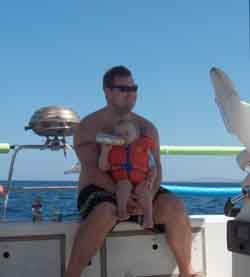
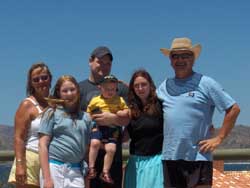 So what did we see in Costa Rica - my blue eyed sons? What did
we see there my lovely young ones? We saw
waterfalls
and
a
volcanoe that was not a smoking. We saw wonderous
rain forests
on the top of Monte Verde. We rode
zip lines and swings right
through the forest. We swam in
warm water bays
where the surfing
was easy. So what did we see in Costa Rica - my blue eyed sons? What did
we see there my lovely young ones? We saw
waterfalls
and
a
volcanoe that was not a smoking. We saw wonderous
rain forests
on the top of Monte Verde. We rode
zip lines and swings right
through the forest. We swam in
warm water bays
where the surfing
was easy.
We saw a mafia marina and a
blow laden town Where the
long legged ladies laboured late in the night. We saw
tropical
gardens and scarlet winged
butterflies.
Humming birds hovering,
don't forget the
howler monkeys. We saw roads so bad they would
bust up your axles. We lounged in the comforts of
exotic resorts, and rode
concrete water slides
down to the water. Where we
swam
and we swam until we could swim no more.
But best of all, yes best of all, Josh,
Harper, Thea and Justin joined us for an action packed two weeks of
adventure in
Costa Rica. We took big bites of Costa Rica. It was very
good.
|
|
| |
|
El Salvador
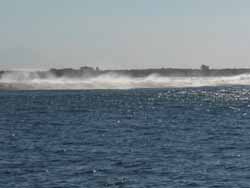 We were looking forward to
visiting Bahia del Sol in El Salvador. A Vancouver couple from our
offshore sailing club - the Blue Water Cruising Association operates a marina there. From
most
reports it is a great place to visit. However, we were
forewarned about its tricky entrance. It has a challenging
marine bar. A
marine
bar is an area of rough water that blocks the entrance. The
bar was extremely rough the day we arrived. Click the picture at
the left to see the waves
breaking over the entrance. We were looking forward to
visiting Bahia del Sol in El Salvador. A Vancouver couple from our
offshore sailing club - the Blue Water Cruising Association operates a marina there. From
most
reports it is a great place to visit. However, we were
forewarned about its tricky entrance. It has a challenging
marine bar. A
marine
bar is an area of rough water that blocks the entrance. The
bar was extremely rough the day we arrived. Click the picture at
the left to see the waves
breaking over the entrance.
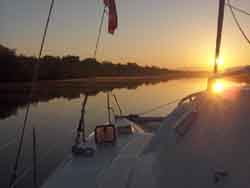 So we had to push on another 20
miles to our alternative achorage Barillas. The rought bar
at Bahia del Sol was
a blessing, because Barillas was a delight. So we had to push on another 20
miles to our alternative achorage Barillas. The rought bar
at Bahia del Sol was
a blessing, because Barillas was a delight.
Barillas turned out to be a resort for the rich and famous of El Salvador.
It was a virtual paradise. What we saw of the rest of El Salvador
confirmed that we were in one of the finest marine resorts in the
country. According to a local news report, the president of El
Salvador frequents the resort and often talks to visiting yachtsmen in
such an informal way that most don't realize who they are conversing
with. We did meet such a man and perhaps he was the President.
One of the resort staff reported that the President was staying at the
resort.
Regardless, the resort was brilliant. And the song birds filled
the air with exhotic tropical sounds. Several sounded like a common
cell phone ring! Click
here to hear the birds and view some sites
from El Salvador and Barillas.
|
|
Guatemala
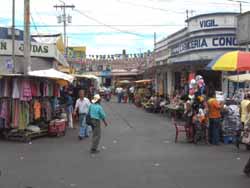 Culture shock! Culture shock!
After months in Mexico we were unprepared for
the abrupt change in living conditions. Guatemala shocked us with
its towns overflowing with people, multitudes of businesses
overflowing in the streets, sardine can buses and beautiful
mountains.
We landed in Puerto Quetzal, then traveled inland by chicken
bus to Antigua. Antigua is the old capital of the
Guatemalan Empire, which bound most of Central America under
Spanish influence. Click here for a picture tour of Antigua.
Chicken buses.
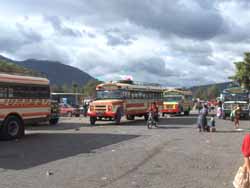 These owner operator buses move people
all over Central and Southern America. The owners often decorate
them with festive paintings and/or neon lites. Because revenues
depend upon picking up customers, the owner work hard, stopping
everywhere and whistling and honking to attacked the attention of
potential customers. With a chicken bus, there is always room for
another customers. Packed in like sardines, we sat on seats build
for two with as many as five adults and children packed in. On one
bus the ticket taker had to walk on the backs of the seats to collect
fares. The name chicken bus applies in three ways. The
drivers play chicken with each other, the customers are known for
bringing their chickens aboard, and some of the buses look so bad, you
may be playing chicken to ride them. View a short chicken bus pictorial
by clicking here. These owner operator buses move people
all over Central and Southern America. The owners often decorate
them with festive paintings and/or neon lites. Because revenues
depend upon picking up customers, the owner work hard, stopping
everywhere and whistling and honking to attacked the attention of
potential customers. With a chicken bus, there is always room for
another customers. Packed in like sardines, we sat on seats build
for two with as many as five adults and children packed in. On one
bus the ticket taker had to walk on the backs of the seats to collect
fares. The name chicken bus applies in three ways. The
drivers play chicken with each other, the customers are known for
bringing their chickens aboard, and some of the buses look so bad, you
may be playing chicken to ride them. View a short chicken bus pictorial
by clicking here.
Chichicastenango is a market town in the highlands of
Guatemala. It is a market town to rival all market towns.
The commerce is astounding. Layer on layer of commerce. The
layers look something like this:
First they have the normal shops you would expect to see in any
town.
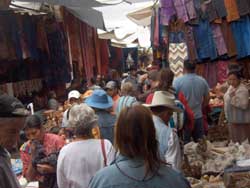
Second, in front of the shops, vendors come in and put up make
shift stalls, usually with a table to display their wares and a
roof.
Third, in front of the make shift stalls, more merchants, spread
their rugs to display goods for sale and sit almost under the
tables.
Fourth, more vendors pile their wares on their shoulders or on their
heads and walk around selling things.
Fifth, on the corners where there is the most traffic, more
merchants will spread their wares on the ground, and get indignant
if you stop on their goods.
Sixth, after you have bought all you need, you find
distributors on the side side streets, who will sell you the same
thing at 1/2 the price.
Wow what a place. I don't think I would go back, but it
Chichicastenango has to be seen to be believed. Click
here to see our rather
paltry collection of photos.
|
|
| |
|
Doing the Tehauntepec Tango
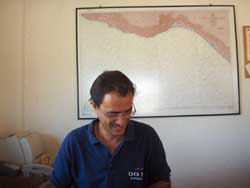 The
anticipation, the waiting and the watching the weather before hand sure
built up the tension for crossing the challenging and often stormy Gulf
of Tehauntepec
in southern Mexico. We hung out at the Haultco marina for a few
days and watched the weather and discussed strategies for crossing this
difficult piece of water. The
anticipation, the waiting and the watching the weather before hand sure
built up the tension for crossing the challenging and often stormy Gulf
of Tehauntepec
in southern Mexico. We hung out at the Haultco marina for a few
days and watched the weather and discussed strategies for crossing this
difficult piece of water.
Enrique, pictured to the right has seen hundreds of boats cross the
Tehauntepec and rescued a few. Three boats were lost in the month
preceding our crossing. That is a chart of the Tehauntepec on the
wall behind him. We followed his advise.
Our weather window came a day early and we jumped through pronto. The plan was
to sail close to shore, up to latitude 16 then hang a right and dash across,
then south east down the other coast. That minimizes risk in the event
the weather changes to nasty.
We had light reaching winds and sailed under spinnaker until dark. At
dusk we tucked in the obligatory night time reef and dumped the chute.
We light up the diesels to maintain 5 knots in a failing breeze.
About 3 hours after dark, I hear the sea running. Current - like
we hear in the Straights of Georgia. Sally slows to about 4.5 knots and I figure
the current is from the
large lagoon at the head of the gulf dumping water with the falling tide.
An hour later the depth sounder shows 20 feet. Shite! 10 feet - 8 feet.
Triple SHITE! Reverse engines, swing the boat around and retreat back up
Sally's track. Depth goes - 10', 20' 40' 100' - we are out of trouble
and OK. I double check position. We
are in a shipping lane for heaven sake! 100 feet of water shown on the
chart!! Now the charts of Mexico are not that accurate, but
this would seem to be an impossibly gross error. We must have
sailed over a whale or something to trigger the depth sounder
incorrectly.
Back to course. Depth goes 50', 40', 30' 10' 5'. Holly CRAP!!.
Reverse again and retreat back down the course line. This time we turn
right and run down lat 15.87 instead of 16. No more depth problems.
What could have been the problem? Whale? Huge school of
fish? Submarine? Does Mexico have subs? I don't know.
As we approached longitude 095 - about 10 miles away, winds pipe up to 20-25 range
and stay that way until about 40 miles the other side. More reaching
weather - yaahooo :-) 7-8 knots with white sails and a reefed main.
Rolled in the jenny a couple of times to keep boat speed under 8 and
minimize pounding.
Then we turn right and reach south east down Mexico's south west coast on the
east side of the Gulf. Blue chute pulling like a freight train. Contrary
current gone. Speed in low eights, flat seas and 12 knots of breeze.
We crossed the Gulf of Tahauntepec.
Fine fine sailing weather.
|
|
| |
|
Crabs in My Ears
A weekly chore on a sailing boat in the tropics is cleaning the bottom
of the boat. The problem is that a dirty bottom slows the boat.
The growth of a multitude of sea creatures adds resistance to the boat
sliding through the water. Speeds are slower and fuel consumption
goes up. It looks bad too.
The tenacity of the sea creatures that make there home on the bottom
of Mustang Sally is amazing. The pink barnacles move in
first. They grab hold of an area and stake a claim. Having
established ownership, the barnacles sub divide and auction off
properties to new families of barnacles, crabs, shrimp and other creatures.
These creatures are tiny. Without a microscope you have to examine
the creatures close up and look hard to discern their tiny features.
Tiny claws on a creature smaller than a crumb of bread. After a
few days, whole communities of these tiny creatures
participate and soon a booming eco-system is
running rampant on the bottom of the boat. The population swells
to thousands and tens of thousands.
Then along comes the grin reaper. With a stoke of my squeegee I
wipe out whole neibourhoods. The residents flee to the water. The
water is thick with their presence and it is necessary to alternate
sides and work from front to back to avoid being immersed in a veritable
sea of the sea creatures. But some find a new home. On the
grim reaper - me. They don't seem to mind where they live.
Most
wash off easily with soap. But a few of the enterprising creatures
find an orifice in which to ensconce them selves. How would you
like a crab or a shrimp living in your ear? Yeeetch.
Wiggling and squiggling, tickling my eardrum. We chased them out
with rubbing alcohol. |
|
| |
|
|
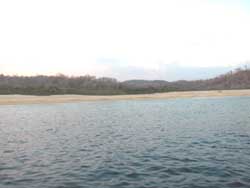 A
beautiful national park in
southern Mexico. The full name is Bahias de Hautulco. There
is no town or city of Hautulco. Just the old town of Santa Cruz
and the recently built tourist town. A
beautiful national park in
southern Mexico. The full name is Bahias de Hautulco. There
is no town or city of Hautulco. Just the old town of Santa Cruz
and the recently built tourist town.
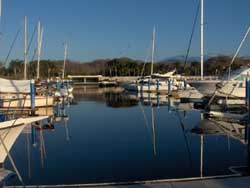 The tourist town
feels just like Ixtapa to the north. Very perfect. Really
really perfect. Just too damn perfect for me. No raw edges
anywhere! Everything arranged in an or so organized manner.
The town designers creativity must have been exhausted after Ixtapa. The tourist town
feels just like Ixtapa to the north. Very perfect. Really
really perfect. Just too damn perfect for me. No raw edges
anywhere! Everything arranged in an or so organized manner.
The town designers creativity must have been exhausted after Ixtapa.
But the Bahias (the bays)! Beautiful, remote, un-populated bays
with cool clear water, coral reefs and miles of white sand. The
diving was great. As the Mexicans say - mucho tranquilo.
Marina Chahui east of Santa Cruz was the finest in all of southern
Mexico. |
|
| |
|
|
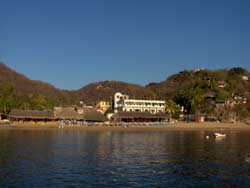 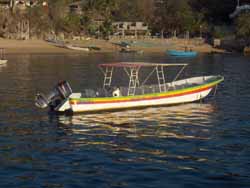 Ah Puerto Angel, what a gem
of a place. Just the right size, a small bay with crystal
clear waters filled with fish and a town of maybe a few thousand souls.
Not crowded with gringo's trying to party hard for a week or so before
returning to their regular lives and responsibilities. Just the
right number of restaurants on the beach. Splashes of color
abound. Bougainvillea and brightly painted houses. Ah Puerto Angel, what a gem
of a place. Just the right size, a small bay with crystal
clear waters filled with fish and a town of maybe a few thousand souls.
Not crowded with gringo's trying to party hard for a week or so before
returning to their regular lives and responsibilities. Just the
right number of restaurants on the beach. Splashes of color
abound. Bougainvillea and brightly painted houses. And we loved
the way the Puerto Angel fishermen parked their pangas. (a panga
is an open boat like the one at the right). Click
here to see how they
park!
Puerto Angel is probably what Zihautanejo was 20 years ago. May it
remain - happily undiscovered, charming and beautiful. Anyone want
a look? Click here
Copyright 2005-6 - Mustang Marine - All rights reserved
|
|
|



